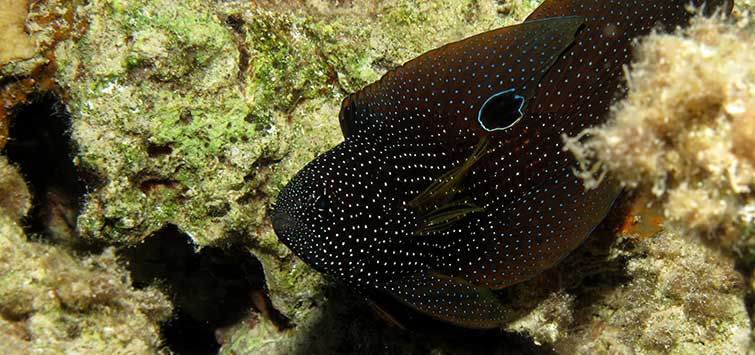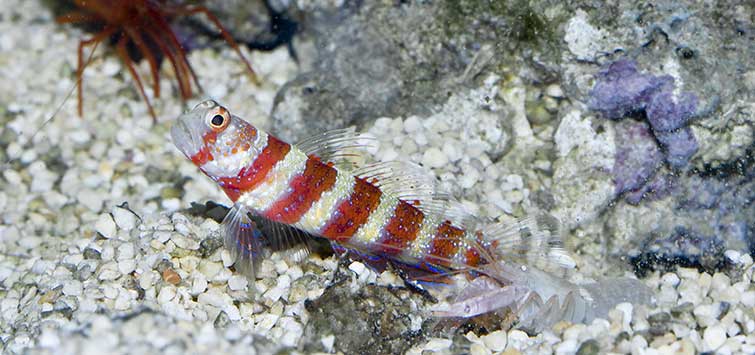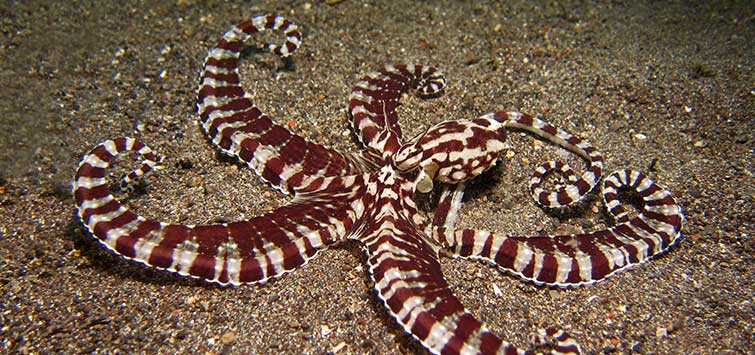Mimicry in Reef Fish Communities
Author: Scott W. Michael
The coral reef fish community is characterized by its incredible diversity and long geological history. Because of these two factors, several fascinating relationships have developed on the reef. Some of these are mutualistic in form, where both or all members of the relationship benefit, such as anemonefishes and sea anemones.
Others appear to be commensal in nature, where one individual benefits but does not harm the other, such as whip coral gobies and whip corals. There are also associations that are parasitic, where one species is harmed while the other benefits, such as isopods that live on and feed on fish body tissue.
What Is Mimicry?
Another group of fascinating piscine relationships involves mimicry. This is where one fish species benefits by resembling another fish or some other organism. Mimicry most often helps a fish avoid being eaten, but there are also mimetic relationships that facilitate prey capture. In this article, we will look at the various forms of mimicry encountered on the coral reef that involve an anti-predation adaptation.
Many of these fish are available to marine aquarists and can be successfully kept in the aquarium. However, the primary purpose of this article is not to discuss aquarium husbandry but to help the aquarist better understand and appreciate some of the amazing fishes available.
Classifications of Mimicry
Some fishes resemble other fish species or invertebrates to dissuade predators from feeding on them. The species that is assuming a false identity is known as the “mimic,” while the organism that is being imitated is called the “model.” Obviously, the two species must share the same geographical range, and the mimic has to be less common than the model so that the predator is more likely to encounter the model and learn to avoid both.
There are several types of mimicry that function to reduce predation. They are Batesian mimicry, MÜllerian mimicry, cleaner mimicry, and social mimicry. Let’s examine these in more detail.
Batesian Mimicry
Batesian mimicry is where a “non-nasty” creature resembles a “nasty” one. A nasty organism is defined as one that is not very palatable (it may taste bad, sport sharp spines, or be venomous or poisonous). Most of the mimicry observed in coral reef fishes falls into this category.
Fish and Invertebrates
Reef fishes may mimic invertebrates to other fishes. For example, one group of invertebrates that serve as models to a number of fish species are the flatworms. Reef fishes rarely eat these worms because of their distasteful or toxic qualities. Not only is the pinnate batfish (Platax pinnatus) brightly colored like a flatworm, but it also swims like one of these invertebrates. A small pinnate batfish will lie on its side and undulate its fins. There are also some frogfishes that appear to mimic flatworms.
For example, the wart-skin (Antennarius maculatus) and painted frogfish (A. pictus) are often attired with striking colors, and they undulate their dorsal fins as they “walk” over the sea floor. Another group of flatworm imposters consists of several tiny flatfishes, which bear a striking resemblance, both in color and form, to these noxious invertebrates.
Sea Slugs
Like flatworms, most nudibranchs, or sea slugs, are also avoided by the generalized predator. Not surprising, there is at least one fish that mimics these animals. This is the post-larval stage of the bridled burrfish (Chilomycterus antennatus), which is thought to mimic an apparently distasteful sea hare known as Aplysia dactylomelia. Both the sea hare and the tiny burrfish live in turtle grass beds in the tropical western Atlantic.
Unpalatable Fish Species
Batesian mimics also resemble unpalatable fish species. For example, there is a grouper known as the false scorpionfish (Centrogenys vaigiensis), and an undescribed species of cardinalfish in the genus Fowleri, that resemble some of the small venomous scorpionfishes of the genus Scorpaenodes or Parascorpaena. This cardinalfish often shares the same shelter sites as the similar-looking Guam scorpionfish (Scorpaenodes guamensis).
Marine Betta and White-Mouth Moray
One of the most fascinating mimetic relationships exists between the comet or marine betta (Calloplesiops altivelis) and the white-mouth moray (Gymnothorax meleagris). When threatened, the comet will move partway into a hole, leaving its expanded tail in full view. The body and tail of this fish are brown with white spots, and there is a distinct eyespot on the edge of the dorsal fin. When assuming this posture, the posterior part of the comet’s body bears a striking resemblance to the head of the white-mouth moray, which typically is encountered with only its head sticking out of the reef.
Blennies
There are also a number of harmless blennies that look and act like the fang blennies (Meiacanthus spp.) described above. Many of these mimic blennies (e.g., Red Sea mimic blenny, Ecsenius gravieri) are amazing imitations of the species they model, while others (e.g., bicolor blenny, E. bicolor) are not as convincing but still seem to derive some anti-predation advantage. There are number of sea bream (Scolopsis spp.) that resemble several poison fang blennies.
One fascinating aspect of the sea bream–blenny mimicry is that the Scolopsis spp. may exhibit different colors depending on the coloration of the sympatric Meiacanthus. For example, in most locations in the western Pacific, the juvenile two-line spinecheek blenny (Scolopsis bilineata) apparently mimics the striped fang blenny (Meiacanthus grammistes) and the lined fang blenny (M. lineatus). However, in Fiji, where M. grammistes and M. lineatus does not occur, juvenile S. bilineata are yellow. In Fiji, they mimic the canary fang blenny (M. ovalauensis). The Indian Ocean form of S. bilineata appears to mimic Smith’s fang blenny (M. smithi).
The pearly spine-cheek (S. margaritifer) exhibits similar chromatic plasticity depending on the fang-blenny common in the area. In some locations (Borneo and the Philippines), the pearly spine-cheek mimics the goldback fang-blenny (M. geminatus). In another region (Papua New Guinea and the Bismarck Archipelago), this same species mimics the one-striped fang-blenny (M. vittatus). It is interesting to note that these same two blennies are mimicked by cardinalfishes in the genus Cheilodipterus.
Surgeonfishes and Pygmy Angelfishes
There are two surgeonfishes and at least one dottyback that mimic the color patterns of certain pygmy angelfishes. The juvenile chocolate surgeonfish (Acanthurus pyroferus) come in two different color phases. One resembles the lemon-peel (Centropyge flavissimus), while the other looks like the half-black angelfish (C. vroliki). Fish expert Rudie Kuiter has also suggested that juvenile A. pyroferus may mimic the bicolor angelfish (C. bicolor) off the coast of Australia. The color phase observed in a particular area is dependent on which model is present there. In the Indian Ocean, the juvenile Indian mimic surgeonfish (A. tristis) is an exact replica of Eibl’s angelfish (C. eibli). Also, there is a pseudochromid, the midnight dottyback (Manonichthys paranox), that is thought to mimic the midnight angelfish (C. nox).
It has been suggested that these are cases of Batesian mimicry, because piscivores quickly learn to avoid eating these angelfishes. But are the pygmy angelfishes unpalatable? It was once suggested that predators would avoid the Centropyge spp. because of the sharp opercular and dorsal spines these angels possess. But field experiments indicate that piscivores will readily eat pygmy angelfishes presented on a fishing line. It has also been proposed that piscivores may avoid trying to capture pygmy angelfishes not because of their spiny armaments, but because it is simply a waste of time and energy.
The fact that pygmy angels never stray far from cover and are quick to retreat at the first signs of danger means that they are very difficult for most predators to capture. Further study is needed to determine the function of these apparent mimetic relationships.
Tobies
One of the most amazing cases of Batesian mimicry occurs between two species of tobies (genus Canthigaster) and two filefishes in the genus Paraluteres. One of these models is the saddled toby (Canthigaster valentini), which is mimicked by the blacksaddled mimic filefish (Paraluteres prionurus). The resemblance between the two species is so striking that careful examination of the fins is required to separate them (the filefish has two dorsal fins; the toby does not). The tobies are toxic and are avoided by many generalized piscivores.
It has been suggested that the juvenile black saddle coral grouper (Plectropomus laevis) may also mimic the unpalatable saddled toby for similar reasons. There is also an undescribed species of filefish from the Andaman Sea that mimics the ocellated toby (Canthigaster solandri), while the Red Sea mimic filefish (Paraluteres arquat) from the Red Sea mimics the pearl toby (C. margaritata).
MÜllerian Mimicry
MÜllerian mimicry is where two “nasty” creatures that share a common predator will share a similar warning signal. If a piscivore has a bad experience with one of these “nasty” species, it will learn to avoid them both. This type of mimicry is rare in the coral reef environment, being best represented by certain blennies that have venomous fangs and resemble one another. These are the striped fang blenny (Meiacanthus grammistes), lined fang-blenny (M. lineatus), short-head fang blenny (Petroscirtes breviceps), and yellow fang-blenny (P. fallax).
Although it has not been conclusively demonstrated, it has been suggested that juvenile sweetlips (Plectorhinchus spp.), many of which are similar in overall appearance and behavior, may actually be distasteful. If these fishes are noxious, then they would be effective MÜllerian mimics of one another.
Cleaner Mimicry
Cleaner fishes are rarely eaten by other fish species because of the valuable function they serve in the reef community. It is not surprising, then, that there are a few fish that may derive some degree of protection by mimicking cleaners. Species like Springer’s dottyback (Pseudochromis springeri), the false cleaner blenny (Aspidontus taeniatus), and the bluestriped fang blenny (Plagiotremus rhinorhynchus) fall into this category. The aforementioned blennies are also aggressive mimics of the blue-streak cleaner wrasse (Labroides dimidiatus), biting off pieces of fin or scales when a fish approaches them to have parasites removed.
Social Mimicry
This form of mimicry is exhibited by species that form schools or shoals. There is safety in numbers. However, an individual that stands out from the other members of a shoal or school will be more vulnerable to predation than will other group members that look alike. In order to take advantage of the “dilution of risk” that occurs when living in groups, some reef fishes adopt the coloration of, and associate with, schooling or shoaling species.
Peach Anthias and Bartlett’s Anthias
For example, around Christmas Island, in the Line Islands, the dispar or peach anthias (Pseudanthias dispar) adopts the color pattern of the more abundant Bartlett’s anthias (P. bartlettorum). Both species naturally occur in shoals. On the other hand, the midas blenny (Ecsenius midas) is a solitary species that also mimics the color pattern and lives within groups of Bartlett’s anthias. In other regions, the Midas blenny mimics and lives among groups of lyretail anthias (P. squamipinnis).
Threadfin Anthias and Fusilier Damselfish
In the Maldives, the threadfin anthias (Nemanthias carberryi) and the fusilier damselfish (Lepidozygus tapienosoma) apparently engage in social mimicry. The threadfin anthias displays two different color forms. One is orange and red, while the other is yellow and magenta. The threadfin anthias is sympatric with both the flame anthias (P. ignitus) and Evan’s anthias (P. evansi), and in the Maldives, it is less common than either of these two forms.
When diving in the Maldives, I have often observed small groups of purple and yellow threadfin anthias swimming amid shoals of the more numerous Evan’s anthias, which is also purple with a yellow dorsal region. On the other hand, the orange-and-red color morph of threadfin anthias was found mixing with groups of flame anthias, which are also similar in color. One of these heterospecific anthias groups was also joined by fusilier damselfish, which were similar in color, and in overall shape to the anthias. This damselfish is known to mimic other species of anthias in different locations. For example, in the Line Islands, the fusilier damselfish resembles the olive anthias (P. olivaceous).
Juvenile Blueface Tilefish and Purple Queen Anthias
Likewise, in the western Pacific, juvenile blueface tilefish (Hoplolatilus starcki) associate and appear to mimic the purple queen anthias (P. pascalus) and male yellow-stripe anthias (P. tuka). Any of these mimetic associations can make for an interesting display in the home aquarium, although most of these species can present special husbandry challenges.
Mimic Goatfish and Blue-Line Snapper
The mimic goatfish (Mulloidichthys mimicus) is also a social mimic that lives among shoals of blue-line snapper (Lutjanus kasmira). This goatfish is known only from reef areas around the Seychelles, Line, and Marquesas Islands.
Blackline Fangblenny and Cardinalfishes
Not all social mimics associate with shoaling species like anthias or certain snappers. The juveniles of the blackline fangblenny (Meiacanthus nigrolineatus) look like, and live with, aggregations of cardinalfishes—in particular, Lachner’s cardinalfish (Cheilodipterus lachneri) and the fivelined cardinalfish (C. quinquelineatus). These mixed aggregations shelter among the spines of the longspine sea urchin (Diadema setosum).
Valuable Experience
I hope this article helps you to better appreciate some of the fishes you may be keeping in your own aquarium. Keeping reef fish is a wonderful experience, and their behavior is so complex and fascinating that many books have been written on the subject. I recommend that all marine aquarists learn more about fish behavior, as it makes keeping a marine aquarium even more interesting.

.png?h=595&iar=0&w=2781&hash=5FD5E69473BCC22199FBFA2FB71B6033)



